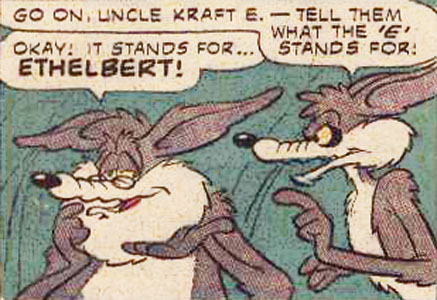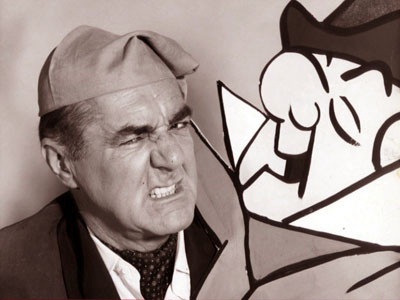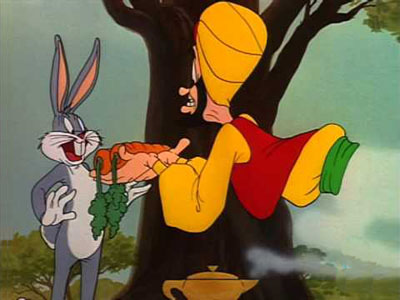
We all love Wile E. Coyote, the long-suffering Road Runner chaser. But, uh, what does the "E" stand for?
I guess I don't know. I mean, none of the cartoons directed by Charles "Chuck" Jones and written by Michael Maltese ever said. Only a couple of them ever even said his name was Wile E. Coyote.
But it has just (this morning) been brought to my attention — thank you, Devlin Thompson — that more than a thousand websites say the Coyote's middle name is Ethelbert. The source for this is a 1973 story that appeared in the comic book, Beep Beep the Road Runner, published by Western Publishing Company under its Gold Key imprint. This is noted by Jon Cooke over on this page and as he also reveals, it was the question/answer to the Final Jeopardy question on the 1/18/07 episode of the game show, Jeopardy!
In the story, which was called "The Greatest of E's," Wile E. Coyote realizes he doesn't know and gathers together some of his relatives to answer the question. One is an uncle named Kraft E. Coyote who informs him and the world that the "E" stands for Ethelbert. That is, as far as I know, the only piece of fiction licensed or otherwise blessed by the Warner Brothers company that ever said such a thing.
This raises one of those moral issues that has no firm answer. What makes something like this an "official" fact in the world of animated cartoons? I mean, we know Bugs Bunny is named Bugs Bunny because…well, we just know. But what is the name of the frog that sings and dances in the Jones-Maltese masterpiece, One Froggy Evening? It's Michigan J. Frog, right? Apparently…but that name appears nowhere in the cartoon. As I understand it, the moniker was coined years later when there was some merchandising interest in the character…or maybe when W.B. decided to try and generate some merchandising interest. Chuck or Mike may have come up with it then or someone at WB may have and then Chuck and Mike endorsed and used it…but anyway, that's the frog's name. I suppose. I mean, if the guys who made One Froggy Evening didn't argue the point, who are we to say it isn't?
For that matter, even if some "fact" appears in a cartoon that doesn't make it inviolable. There were WB cartoons where Sylvester the Cat could talk and was owned by Granny. There were others where he couldn't talk and was Porky Pig's cat. Quick: If I asked you, "Who owns Sylvester?," you'd probably forget about all cartoons to the contrary and say it was Granny, who also owned Tweety. There were Bugs Bunny and Daffy Duck cartoons where for no apparent reason, those characters lived in other eras. Elmer Fudd had a couple of different middle initials in different shorts and characters' appearances were often changing and we could list hundreds of other inconsistencies. The films weren't intended to have an airtight continuity from one to another. Some "facts" were meant to be forgotten.
It was the same with the comic books. Western Publishing licensed the right to do comics of those characters for around thirty years, and the editors at Western thought of the comics as separate entities from the cartoons. The Donald Duck that Carl Barks and others wrote and drew for Western's Disney comics was not exactly the same Donald Duck that appeared in the Disney cartoons. They adapted the character, rethinking and redesigning him for a different medium. (It's a funny thing: When I was a kid and read Bugs Bunny comic books, I always "heard" the wabbit's dialogue in Mel Blanc's voice from the shorts. But when I read a Donald Duck comic book, I never thought that duck spoke with the voice Clarence Nash supplied for Donald in his cartoon appearances…maybe because I understood so little of what the animated duck said and I could read every syllable of the comic book Donald's word balloons.) In some ways, the Donald of the comics was the same character but in others, he was a different but similar creature. And I never quite related the Mickey Mouse of the comic books or strips to any of his animated appearances.
While Western was doing the Warner Brothers-based comics, they changed a lot of the characters to make them — they thought — more workable for print media. They didn't think matching the cartoons closely mattered because, for one thing, those films weren't on TV every week then. During the forties and early fifties, they weren't on TV at all. Many of the kids who bought the comics rarely, if ever, saw the animated shorts and certainly didn't see them over and over and over, like they would in later years. So it didn't matter a whole heap if the comics matched the cartoons; only that they worked as comic book reading experiences. Back then in the Bugs Bunny newspaper strip, which was read by millions, Elmer Fudd rarely appeared and I don't think Yosemite Sam ever did…but Sylvester was a regular. He was a hobo who wasn't owned by Granny, didn't chase Tweety Birds and who had a British accent. Someone thought it made for a better strip that way.
This is why, for instance, the Road Runner in comic books differed so much from the Road Runner in cartoons. When I was a kid enjoying both, I was puzzled. I'd seen Road Runner cartoons. They were tough to come by then but I'd caught one or two and in them, there was one Road Runner and one Coyote and neither spoke. In the comics, the Road Runner not only spoke, he spoke in rhyme. He had a name — Beep Beep — and in some stories, he had a wife and a family of either three or four youthful road-running kids. The Coyote spoke too, though not in rhyme, though that didn't bother me as much. The Coyote had spoken in a couple of non-Road Runner cartoons.
I wondered aloud back then if the folks who made the comic books had ever viewed one of those hard-to-see cartoons — but of course, they had. As I learned much later, Michael Maltese wrote many of those comics and the early ones were drawn by Pete Alvarado. Pete handpainted all the backgrounds for the first Road Runner cartoon, Fast and Furry-ous. Almost all the other writers and artists who did the comics (Phil DeLara, Don R. Christensen, Warren Foster, et al) had worked for the Warner Brothers cartoon studio, if not in Jones's unit then right down the hall. They knew that in the cartoons, the Road Runner didn't talk — in rhyme or at all and it had been a conscious decision to change it for the comics. The editors and creators had also decided to not worry about consistency from comic book to comic book. In some, there was a Mrs. Road Runner and four kids. But there were several years there where the wife and one of the kids disappeared…except that every now and then, they'd inexplicably turn up for a story or two or in a reprint sandwiched in among new adventures.
So as far as I'm concerned, it's no more a "fact" that the Coyote's middle name is Ethelbert than it is that the Road Runner is named Beep Beep, has a wife and kids and speaks in doggerel. It said the "E" stood for Ethelbert in one comic book story but that's just one obscure comic book story…and even the guy who wrote it didn't intend it as anything more than one joke on one page of one story in one issue.
How do I know this? Because, as some of you may have guessed by now, I was that guy. I wrote that story. I think I was around twenty years old at the time. I'm pretty sure, by the way, that that one was conceived in a lecture hall at U.C.L.A. while I was simultaneously jotting down script ideas and feigning attention to what a tedious Anthropology professor was teaching. Mike Maltese had been occasionally writing the comics in semi-retirement before me…but when he dropped the "semi" part, I got the job and that was one of the plots I came up with. For the record, the story was drawn by a terrific artist named Jack Manning, and Mr. Maltese complimented me on it.
Still, I wouldn't take that as any official endorsement of the Coyote's middle name. If you want to say the Coyote's middle name is Ethelbert, fine. I mean, it's not like someone's going to suddenly whip out Wile E.'s actual birth certificate and yell, "Aha! Here's incontrovertible proof!" But like I said, I never imagined anyone would take it as part of the official "canon" of the character. If I had, I'd have said the "E" stood for Evanier.



